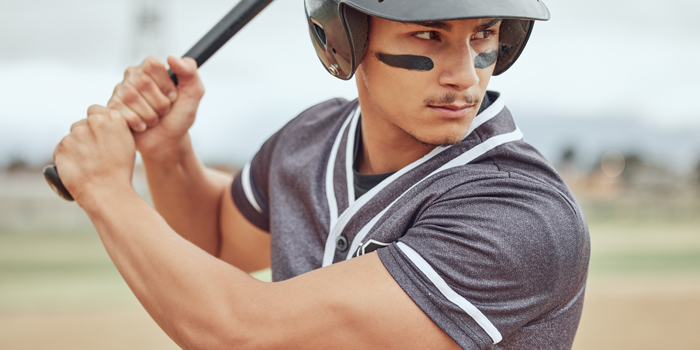
The sport of baseball has some of the most unilateral, one-side dominant athletes you will come across due to the sport's repetitive nature. For example, a right-handed starting pitcher who doesn't miss a start and averages, let's say, 70 pitches an outing will throw 420 pitches in a month. Multiply that by five months, and you're looking at upwards of 2000 pitches in a season!
Working in a rehab setting, I have seen some consistencies with some of our younger players. Several of our athletes who return to Arizona on rehab struggle with pelvic control. They often cannot get into a proper hinge, let alone feel what it's like to load their hips effectively. Athletes who live in extension and are required to perform high-velocity repetitive movements from one side of their body for a living and who cannot hinge or load their hips effectively can find themselves developing a variety of compensations that can contribute to a multitude of injuries up the chain.
I've had athletes come back to me with lumbopelvic injuries, lower body soft tissue injuries, and even elbow/UCL injuries which is an extensive rehab process. Everything travels up the chain in athletics; if athletes do not have a solid base and ability to utilize their lower half, pitchers' bodies will look elsewhere up the chain to generate velocity consistently.
Ultimately, that can place a large amount of valgus force and stress on the shoulder and elbow throughout an entire season. This is why early development of a solid prehab program for your baseball athletes is essential. Focusing on their pelvic positioning and control can go an incredibly long way in their development and ability to stay on the field. And in the minor leagues, sometimes just being available on a more consistent basis than the guy next to you can be the difference in getting called up a level, or in some instances, I've even seen it make the difference in getting the call to go to the major leagues.
Understanding Patterns
Due to the combined factors of the unilateral nature of the sport and overall right-side dominance, many baseball players may fall into a left AIC pattern. This is when the pelvic girdle is anteriorly rotated and tipped forward on the left and posteriorly rotated and tipped backward on the right. The long-term effects this can have on one's lower extremity are excessive external rotation of the left femoral head in the acetabulum, resulting in the posterior muscles crossing the joint becoming short and tense, while the opposite occurs on the right side. As a result, one can expect symptoms in the knee, hip, groin, sacroiliac joint, back, top of the shoulder, between shoulder blades, neck, face, etc.
Research has looked at pitchers with poor quality of movement through their lower AIC and found a direct link between that and arm health (Stodden et al. 2014). Furthermore, research has shown that around 50% of patients with SLAP labrum tears show lower body kinetic chain deficits (Kibler et al. 2013).
Let's look at how Left AIC patterns affect each side from a musculoskeletal standpoint.
Left Side:
- Illiacus/Psoas: overactive pulling body into flexion and external rotation.
- TFL (tensor fascia latae): short and strong, compromising anterior glute medius ability to internally rotate the femur.
- Posterior Glute Medius: short and strong, creating abduction and external rotation.
- Adductor Magnus/Longus: long and weak due to the femur's external rotation.
- Glute Max: External rotator fibers are short and strong/extension fibers are long and weak due to positional flexion.
Right Side:
- Illiacus/Psoas: long and weak, the body is in a state of extension and internal rotation.
- TFL: long and weak, compromising posterior glute medius ability to externally rotate the femur.
- Anterior Glute Medius: short and strong, internally rotating femur.
- Adductor Magnus/Longus: short and strong due to the femur's internal rotation.
- Glute Max: External rotator fibers are long and weak, and extension fibers are short and strong due to positional extension.
In baseball terms, let's look at what a right-handed pitcher needs from a muscle activation standpoint on the mound:
- Wind-up – Need to turn on right posterior glute med to delay LAIC activity.
- Stride – Need to inhibit the right adductor to maximize stride length.
- Cocking – Need to shift into Left AF IR while maintaining right trunk rotation.
- Acceleration – Need to keep Left AF IR in trunk flexion.
- Follow through – Need to balance into left AF IR.
The top picture shows a right-handed pitcher who cannot get his left leg into AF IR (acetabulum femoral internal rotation). The bottom picture is a right-hander who can get into left AF IR. Getting pitchers to have proper hip rotation allows for better alignment and direction during pitching motion, allowing for proper pelvic and trunk rotation and an improved ability to generate torque (Stadden et al.).
Programming
When designing my activation and overall training programs, I ensure I address a handful of key areas, depending on the athlete's current physical capabilities or injury. First, I like to ensure that my athletes who live in extension can go into flexion and control their pelvis effectively through some simple breathing/bracing technique. For instance, I often include Dead Bugs with a towel under their low back while I pull on it; this forces them to move their pelvis, brace their core, and get out of extension.
I'll also use exercises from the Postural Restoration Institute (PRI) because they aid in pelvic positioning and diaphragmic breathing/bracing. Furthermore, lots of exercises from PRI can help players use their hamstrings and adductors more effectively. I believe the adductors are one of the most undertrained muscle groups in baseball strength and conditioning currently. However, their importance in a sport composed of ballistic lateral movements cannot be understated. This is why I believe heavily in prescribing lateral-biased plyometrics and strength training exercises in my programs.
In closing, baseball players can develop significant biomechanical and lumbopelvic deficiencies if left untreated. Start programming from the ground up, perform a needs analysis, and analyze how they load and move both on the field and in the weight room. Pelvic deficiencies such as left AIC patterns, poor loading patterns, and an inability to move into flexion can not only affect their performance but often can lead to injuries up the chain. Addressing pelvic control, bracing techniques, and loading patterns early on can help your athletes, regardless of their skill level, stay on the field and give themselves the best opportunity to succeed.
References
- Kibler et al., (2013). The disabled throwing shoulder: spectrum of pathology. Journal of Arthroscopic and Related Surgery, (29): 141-161.
- Stodden et al., (2014). Original research relationship of pelvis and upper torso kinematics to pitched baseball velocity. Journal of applied biomechanics. (17):2
- Laudner, K., Wong, R., Onuki, T., Lynall, R., Meister, K., (2015). The relationship between clinically measured hip rotational motion and shoulder biomechanics during pitching motion. J Sci Med Sport, (5): 581-4.
Header image credit: peopleimages12 © 123rf.com

Dwayne Peterson has worked in professional baseball for eight years. Six of those years were spent working as a minor league S&C with the Houston Astros, where he worked as an S&C at every level in the minor leagues from short season to AAA—fortunate enough to be a part of the organization during the 2017 World Series Championship Season. Dwayne is currently the Rehab S&C coach for the San Diego Padres organization. He completed his undergraduate degree in exercise science and MBA at Northern Kentucky University and is in the process of obtaining his Ph.d. Dwayne spends his offseason at home with his wife and three dogs in Erlanger, Kentucky.










3 Comments